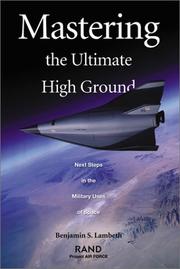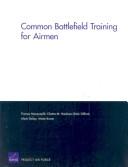| Listing 1 - 10 of 68 | << page >> |
Sort by
|

ISBN: 083303412X 0833033301 9780833034120 9780833033307 Year: 1999 Publisher: RAND Corporation
Abstract | Keywords | Export | Availability | Bookmark
 Loading...
Loading...Choose an application
- Reference Manager
- EndNote
- RefWorks (Direct export to RefWorks)
Assesses the military space challenges facing the Air Force and the nation in light of the findings and recommendations of the Space Commission. The author reviews the Air Force's involvement in space since its creation as an independent service in 1947; examines the circumstances that occasioned the commission's creation and the conceptual and organizational roadblocks that have impeded a more rapid growth of U.S. military space capability; and enumerates the challenges facing the Air Force with respect to space.
Astronautics, Military --- United States. --- United States --- Military policy. --- AF --- Air Force (U.S.) --- U.S.A.F. --- United States Air Force --- US Air Force --- USAF --- AF (Air force) --- U.S.A.F. (Air force) --- USAF (Air force)
Book
ISBN: 0833089943 9780833089946 9780833084361 0833084364 Year: 2014 Publisher: RAND Corporation
Abstract | Keywords | Export | Availability | Bookmark
 Loading...
Loading...Choose an application
- Reference Manager
- EndNote
- RefWorks (Direct export to RefWorks)
This report provides the results of Air Force weapon system cost growth analyses based on the RAND Corporation's internal Selected Acquisition Report database. The database provides consistent, current metrics to support analyses both within RAND Project AIR FORCE (PAF) and in the Air Force acquisition community. This work assesses, quantifies, and documents cost and schedule growth of Major Defense Acquisition Programs (MDAPs) and provides data and detailed program histories.
Air Forces --- Military & Naval Science --- Law, Politics & Government --- United States. --- Appropriations and expenditures. --- Weapons systems --- Costs. --- AF (Air force) --- Air Force (U.S.) --- U.S.A.F. (Air force) --- United States Air Force --- US Air Force --- USAF (Air force)
Book
ISBN: 083308674X 9780833086747 9780833082152 0833082159 Year: 2014 Publisher: RAND Corporation
Abstract | Keywords | Export | Availability | Bookmark
 Loading...
Loading...Choose an application
- Reference Manager
- EndNote
- RefWorks (Direct export to RefWorks)
Military & Naval Science --- Law, Politics & Government --- Air Forces --- United States. --- Reserves --- Organization. --- Operational readiness. --- Mobilization. --- AF (Air force) --- Air Force (U.S.) --- U.S.A.F. (Air force) --- United States Air Force --- US Air Force --- USAF (Air force)
Book

ISBN: 9780833090041 0833090046 9780833081414 0833081411 9780833081414 Year: 2014 Publisher: RAND Corporation
Abstract | Keywords | Export | Availability | Bookmark
 Loading...
Loading...Choose an application
- Reference Manager
- EndNote
- RefWorks (Direct export to RefWorks)
The focus of this analysis is on how enhanced ACS processes can be implemented and integrated into the Air Force and Joint command and control (C2) enterprise. Using the vision for enhanced C2 provided in the updated architecture developed as a companion piece to this analysis, we identify and describe where shortfalls or major gaps exist between current ACS processes (the AS-IS) and the vision for integrating enhanced ACS processes into Air Force C2 (the TO-BE). We evaluate C2 nodes from the level of the President and Secretary of Defense (SECDEF) to the units and sources of supply. We also evaluate these nodes across the operational phases, from readiness preparation through planning, deployment, employment, sustainment, and reconstitution.
Command and control systems --- Military planning --- United States. --- Operational readiness. --- AF (Air force) --- Air Force (U.S.) --- U.S.A.F. (Air force) --- United States Air Force --- US Air Force --- USAF (Air force)
Periodical
ISSN: 19361823 19361815 Publisher: Air University Press
Abstract | Keywords | Export | Availability | Bookmark
 Loading...
Loading...Choose an application
- Reference Manager
- EndNote
- RefWorks (Direct export to RefWorks)
Strategic Studies Quarterly (SSQ) is the peer reviewed strategic journal of the United States Air Force, fostering intellectual enrichment for national and international security professionals. SSQ provides a forum for critically examining, informing, and debating, national and international security matters.
Strategy --- United States. --- AF --- Air Force (U.S.) --- U.S.A.F. --- United States Air Force --- US Air Force --- USAF --- Strategy. --- Military strategy --- Military art and science --- Military doctrine --- AF (Air force) --- U.S.A.F. (Air force) --- USAF (Air force) --- Military Science - General --- Stratégie --- États-Unis. --- Stratégie --- États-Unis.
Book
ISBN: 1281736678 9786611736675 0833045857 0833044818 0833042106 9780833045850 9780833042101 9781281736673 9780833044815 Year: 2008 Publisher: Santa Monica : RAND Corp.,
Abstract | Keywords | Export | Availability | Bookmark
 Loading...
Loading...Choose an application
- Reference Manager
- EndNote
- RefWorks (Direct export to RefWorks)
The methodology developed in this research can be used to quantify and compare the key factors that allow the U.S. Air National Guard to generate peacetime training sorties with a fairly small full-time workforce. The authors apply these insights to proposed Total Force Integration initiatives to evaluate maintenance options for supporting associate units, where the goal of the unit is to produce trained pilots in the most efficient manner possible. The methodology evaluates how various types of personnel can influence the size and productivity of a unit.
Airplanes, Military. --- Airplanes, Military --- Air pilots, Military --- Maintenance and repair. --- United States. --- Operational readiness. --- United States --- Air National Guard. --- Military air pilots --- AF --- Air Force (U.S.) --- U.S.A.F. --- United States Air Force --- US Air Force --- USAF --- Militia --- Air National Guard --- Air pilots --- Aeronautics, Military --- AF (Air force) --- U.S.A.F. (Air force) --- USAF (Air force)
Book
ISBN: 0833081675 0833081705 9780833081704 9780833081674 9780833081674 Year: 2013 Publisher: RAND Corporation
Abstract | Keywords | Export | Availability | Bookmark
 Loading...
Loading...Choose an application
- Reference Manager
- EndNote
- RefWorks (Direct export to RefWorks)
U.S. Air Force (USAF) global posture-its overseas forces, facilities, and arrangements with partner nations-faces a variety of fiscal, political, and military challenges. This report seeks to identify why the USAF needs a global posture, where it needs basing and access, the types of security partnerships that minimize peacetime access risk, and the amount of forward presence that the USAF requires.
Air bases, American. --- United States. -- Air Force -- Foreign service. --- United States. -- Air Force -- History. --- Air bases, American --- Military & Naval Science --- Law, Politics & Government --- Air Forces --- United States. --- Foreign service. --- American air bases --- AF --- Air Force (U.S.) --- U.S.A.F. --- United States Air Force --- US Air Force --- USAF --- E-books --- AF (Air force) --- U.S.A.F. (Air force) --- USAF (Air force)
Book
ISBN: 9786611736460 0833045903 0833041282 9780833045904 9780833041289 6611736468 Year: 2008 Publisher: RAND Corporation
Abstract | Keywords | Export | Availability | Bookmark
 Loading...
Loading...Choose an application
- Reference Manager
- EndNote
- RefWorks (Direct export to RefWorks)
The United States Air Force materiel sustainment system (MSS) is continually caught between two countervailing pressures: demands for increased efficiency and lower costs on one side versus demands for increasingly effective support to combat operations and peacetime training on the other. Furthermore, the demands on the MSS are unpredictable and change rapidly. The authors contend that implementation of a common operating picture (COP) would make the Air Force MSS both more efficient and more flexible and responsive to changing needs.
Airplanes, Military. --- manpower. --- Airplanes, Military --- Logistics --- Military & Naval Science --- Air Forces --- Law, Politics & Government --- Maintenance and repair --- Logistics. --- Maintenance and repair. --- United States. --- Equipment. --- AF --- Air Force (U.S.) --- U.S.A.F. --- United States Air Force --- US Air Force --- USAF --- Military art and science --- AF (Air force) --- U.S.A.F. (Air force) --- USAF (Air force)

ISBN: 1281430099 9786611430092 0833044451 0833041541 9780833044457 9781281430090 9780833041548 Year: 2007 Publisher: RAND Corporation
Abstract | Keywords | Export | Availability | Bookmark
 Loading...
Loading...Choose an application
- Reference Manager
- EndNote
- RefWorks (Direct export to RefWorks)
What does an individual need to be considered an experienced fighter pilot? The current formal definition is based on how many flying hours a person has, but in practice, the question is more complex and sometimes subjective because an individual requires different kinds of experience for combat positions and staff positions. The authors surveyed training experts to discover practical bases for judgments about the experience needed for different jobs. For flying positions, they found that time in advanced simulators is now also considered to be an important component of experience.
Electronic books. --- Fighter pilots. --- Fighter pilots --- Military & Naval Science --- Law, Politics & Government --- Air Forces --- Training of --- United States. --- Aces (Fighter pilots) --- Air aces --- Pilots, Fighter --- AF --- Air Force (U.S.) --- U.S.A.F. --- United States Air Force --- US Air Force --- USAF --- Air pilots, Military --- AF (Air force) --- U.S.A.F. (Air force) --- USAF (Air force)

ISBN: 1281430145 9786611430146 0833044281 0833041851 9780833044280 9781281430144 9780833041852 Year: 2007 Publisher: RAND Corporation
Abstract | Keywords | Export | Availability | Bookmark
 Loading...
Loading...Choose an application
- Reference Manager
- EndNote
- RefWorks (Direct export to RefWorks)
"Members of Air Force specialties that normally work inside the defended perimeter of a base or deployed location may sometimes have to cross that perimeter. What might seem fairly benign in some locations, such as Germany, would be hazardous in others, such as Iraq. And some initially deployed to a "safe" location may be redeployed to a more hazardous one. While those who routinely go "outside the wire" receive appropriate training, the others historically have not. The Air Force is thus seeking to establish common battlefield airman training (CBAT) and asked RAND Project Air Force to examine the content and resources both for this course and a companion course for non-ground combat personnel. RAND conducted surveys and interviews to determine the kinds of experiences airmen have had "outside the wire" and worked with subject-matter experts to categorize them and suggest appropriate types and amounts of training for them. This report presents the results of these activities."--Publisher's website
Aeronautics, Military. --- Electronic books. --- Aeronautics, Military --- Air Forces --- Military & Naval Science --- Law, Politics & Government --- Study and teaching --- United States. --- Airmen. --- Military aeronautics --- Military aviation --- AF --- Air Force (U.S.) --- U.S.A.F. --- United States Air Force --- US Air Force --- USAF --- Military art and science --- Air pilots, Military --- AF (Air force) --- U.S.A.F. (Air force) --- USAF (Air force)
| Listing 1 - 10 of 68 | << page >> |
Sort by
|

 Search
Search Feedback
Feedback About UniCat
About UniCat  Help
Help News
News